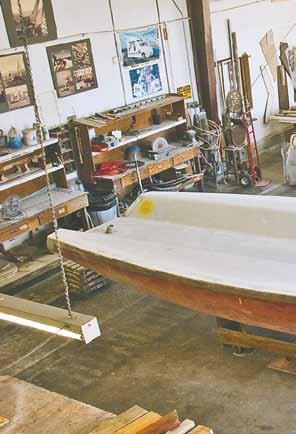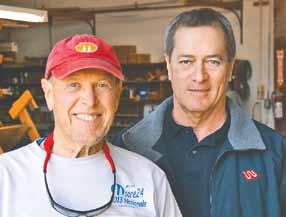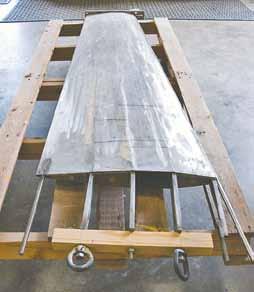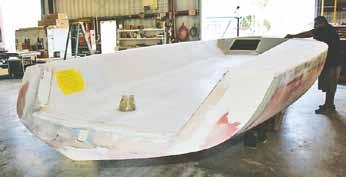
11 minute read
building nemo
In January, the Latitude 38 editorial dungeon received an enthusiastic call from Ron Moore, who was eager to show us the latest boat he was building. "I am completely consumed by the project," he said. You may recognize the name — Ron Moore is the builder of the George Olsondesigned Moore 24, one of the most successful keelboats to ever grace West Coast waters.

Advertisement
A modern computer rendering rests on the drafting table next to old-fashioned pencil drawings and wafers of bulkhead material.
Moore's customer in the new project is Terry Alsberg, another icon of Santa Cruz boat building; Alsberg Brothers Boatworks built the Carl Schumacherdesigned Express 27s, 37s, and 34s in the 1980s. The new boat will be called Nemo, after an Express 27 Alsberg used to own.
Nemo came out of the Express 27 mold in '86 or '87; it was never intended to be a stock boat, but rather a 'funny car'.
'Nemo's stainless steel keel is a work of art. "Ron fi lled it with epoxy foam so it's devoid of any air inside that can distort it," said Alsberg.
"It's a wider layup than a stock 27," said Terry Alsberg. "It's got more glass in it. And we thought we would slice down the shear about 6 inches to reduce windage and weight aloft, and make a fl ush-deck boat that's just a pure race boat. So we built a custom deck for it. And we put in some stringers that went fore and aft to support the cockpit. "In 1988, after we got the project to a certain stage, the Boatworks went bellyup, and this sat on Moore's Reef, where I had learned how to build boats working for Ron. He had a storage yard there with various ferrocement monstrosities and orphan trimarans that were hard on the hard. I was bankrupt and eventually couldn't pay the rent, so Ron repo'd it and sold it. It ended up in Stockton. And then Rob Grant got hold of it." Grant was the racing editor at Latitude 38 at the time. "Rob calls me up and says, 'I hear you had something to do with this boat I bought; I just wanted to know how I should fi nish it off.' I said, 'You don't want to build it. You want me to build it.' So I sweet-talked him into selling it to me for what he paid for it: $2,500 including a rusty old trailer. "I picked it up and was trying to fi gure out where I could get it built. Bill Riedel runs Stretch Surfboards in Santa Cruz. He used to work for me, and he was back over on Tower Place where my company used to be. They took the deck off and tore out a bunch of the interior." But Riedel didn't have time to work on it because the surfboard shop is so busy. "I ran into Ron and Martha one afternoon and I said, 'Hey, you still building boats?' and Ron said yeah, and I said, 'You want to build one?' He said, 'Yeah, I'd love to do that.' So I rolled it on over here." Work on Nemo began in earnest last April. Ron finished removing the rest of the bad interior. Some water had gotten into the hull so he drilled some holes in it and got the water out. "The hull is tip-top now," he said. "We're pretty confi dent that the hull is uber sound," agreed Terry. The deck had a few fl aws in it too, which Ron repaired. "We changed our concept about how the interior was to be done," said Terry. "I started thinking that this thing's basically a big girder — my background is architecture and structural engineering. You have two skins you hold apart with some verticals, so I thought how about if we just break the hull up lengthwise." The carbon bulkheads are about four feet apart. They must weigh something, but when you pick up a slice of the material, it feels weightless. "This is going to make the whole thing into one big box girder that's very stiff on the ends. Boats get a torsion load because you've got a rig pulling one direction, a keel pulling the other direction, and the rudder pulling in another direction. By locking bulkheads athwartships all up and down, we take out those torsional forces. It should be hella stiff." "It's like the Moore 24. It's overbuilt," said Ron. "The way Terry has the keel connect to the hull is very different. Projecting out of the top of the foil are four tapered tabs that fi t in matching slots that are also tapered. You wouldn't even need nuts and bolts to hold it in." "In Santa Cruz we always attached our keels on a stubby," said Terry. "We like stubbies as a way to ease the forces into the hull, rather than just have a hard force on a right angle to the hull surface. In the past when we used to at-



the 'pooka'

ALL PHOTOS LATITUDE / CHRIS EXCEPT AS NOTED
Spread: Moore Sailboats in Watsonville is where Ron Moore is fi nishing 'Nemo', a sort of fl ushdeck Express 27 speedster, for Terry Alsberg, who built the Expresses. The Divinycell foam and balsa-core hull and deck are ready for paint and nonskid. Inset left: Ron and Terry. "I think maybe I'll get to build some more of these," said Ron. Inset right: a view of 'Nemo's transom and cockpit.
tach keels to stubbies, we put the bolts right through the bottom of the stubby. I always thought, you got all that weight hanging off sideways on a knockdown — and actually the side forces on the keel from going upwind are even greater — and it always just seemed sketchy to me, especially with a bulb down that far. So instead of having a 3-inch lever base on bolts like what you have on a Moore 24 or Express 27, these are 8 inches deep and they engage with these G-10 frames. This will take all the side-load." Ron invented a razor-blade kelp-cutting system for the keel à la Melges. "It's only got this one dogged-down Lewmar hatch on it," said Terry. "The kelp cutter comes right up through the middle of that part of the boat, and so I had to get the hatch out of the way. Otherwise you'd open it and walk right into the kelp cutter. Once the hatch went off to the port side, I got that space on the starboard side. I irritated the hell out of Ron by insisting I have that little pooka there. But I thought it would be nice to have a place to stick stuff. You can put winch handles, sheets, blocks, things like that in there. If I'm not racing, just going to Capitola to hang off the hook, I might put some beer in there and some food. Ron says it totally screwed up the interior; it was a really comfortable interior before then… But I fi gure I ain't never going down below on this. Tighten up a few bolts and make sure there's not water sloshing around is about it. It's basically just a big decked-over dinghy. Nobody's going to overnight on this boat." "It's a retro boat with some throwback stuff, like a permanent backstay — no runners — so the rig won't come down in an accidental jibe," said Ron. "The Express 27 rudder has a tendency to lift out of the water and lose control. This will have an 8- to 12-inch deeper rudder." Terry will build the rudder himself. "Ben Hall of Hall Spars will build the carbon mast. We'll have a roller-furled Code Zero and a carbon sprit supported by a jackstay," said Terry. Once complete, the boat will weigh about 1,800-1,850 lbs., 30% less than a stock Express 27, yet with 30% more sail area. "I don't call it a ULDB, I call it a U-ULDB. Ultra ultralight," said Terry. "You want to make anything go fast, make it lighter and put a bigger engine in it. It's going to be a taller rig than the Express 27 but still 9/10ths fractional because I like the way that bends. When Carl and I designed the 27 we jokingly said that we designed it to the Barient 10 rule. The Barient size 10 winch was just big enough to handle the fore-triangle of the Moore 24, which, if memory serves, is 121 square feet. An Express 27 has the exact same square footage in the foretriangle as a Moore, but because it's a bigger boat, we put a bigger main on it.
"The Express 27 has a very seakindly shape. If you look at the transom, it's got what's called dead rise. It's got a little bit of a V there. When these things are going really fast, it's when they're on a close reach, and you're heeled about 10-15 degrees. When this shape is heeled it's fl at, so it's for planing on a shy reach. This is designed to be a really well-behaved boat in big seas and big wind." It will be set up for doublehanding.
Ron and Terry hope to launch the boat in April. She'll mostly be a Wednesday-night hot rod. "Wednesday night racing's real big here in Santa Cruz. There's
An interior view from before the deck went on. The carbon-fi ber bulkheads are nearly weightless, so lightening holes would be overkill.
TERRY ALSBERG

no committee boat, no entry fees, no trophies. One boat decides to be the rabbit for the start of the race, and they call out a course. If you think you beat the boat next to you then you're the hero, but nobody gives you a trophy for it. We all meet back at the yacht club TERRY ALSBERG and lie about how we did." Ron said that Nemo will probably beat Olson 30s. "It will probably kill everybody going to weather." "When Rob Grant sold me the boat for what he paid for it he made me promise to do the Delta Ditch together," said Terry. "And I might do the Trans-Tahoe." Terry fi gures Nemo will set him back about fi ve times what a good used Express 27 would have cost. "I told Terry, it's called boat love. There's just nothing you can do about it. Don'tcha think when you put it in the water and you sail it with your wife," Ron inquired of Terry, "you're gonna forget about the money and just start thinking life's too short, you might as well do something you like?"

This graphic of 'Nemo's gray color scheme also shows her deep, modern rudder and her elegant 108-lb. keel with the 700-lb. bulb.
"I invented Warmboard, a radiant fl oor heating system," said Terry. "Thank God for that or I couldn't afford this whole thing. I came to Santa Cruz in '77 with the idea that I was going to build a boat for myself. I fi gured I should work for a boat builder and learn how to do it rather than hack it up like an amateur. I worked for Ron for three years, then I started Alsberg Brothers Boatworks. I built 268 boats and don't have one now. I fi gured, I came here to build a boat for myself, I should have one. That was a dream for 40 years. Originally I wanted a cruising boat. Then I started understanding ULDBs and got into racing boats. Of all the boats I built, the 27 is my absolute favorite. It's just the most fun to sail. "When I fi rst came here it was right in the heyday of sailing. The yacht club was full of people. There'd be 100 boats out on the water on racing weekends. Bill Lee, Ron Moore, George Olson, John Josephs with Wilderness boats, Alsberg Brothers, and Larry Tuttle — there were six of us in this huge boatbuilding scene. The fastest boats were being built here in little Santa Cruz. And now Ron's building this boat here. It's a nice cherry on top of the sundae." "I just got a call," said Ron. "A guy wants a new Moore 24…"
Right over a cyclone fence from Moore Sailboats on Grove Street in Watsonville is Dave Wahle's boatyard, home of Wyliecat Yachts, where another new boat, the partially-built prototype Wyliecat 40, awaits a buyer or investor. We'll have more on that design in a future issue of Latitude 38.
— chris

Discover Brisbane Marina Discover Brisbane Marina
The Brisbane Marina has completed dredging for our largest slips and channel, and the depth in these berths and in the channel is 8’ at MLLW. Come check out the difference — this is an awesome marina! Dredging of all slips will be completed between June and November, 2016. GREAT LOCATION! Just minutes to Central Bay sailing.
GREAT STAFF!
GREAT RATES! Starting at $6.62/foot! MARINA GREEN with picnic/BBQ areas and Bay Trail access.






